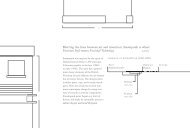The Limit.pdf
You also want an ePaper? Increase the reach of your titles
YUMPU automatically turns print PDFs into web optimized ePapers that Google loves.
CHI<br />
GLOBAL DESTRUCTION 1
T H E L I M I TS<br />
BY LYDIA HAN - [310]8802976 / www.njoyit.cc<br />
Instructor - Paul Hauge | Art Center College Of Design<br />
All Copyright Reserved. Please disturb, copy and share!<br />
CHI<br />
GLOBAL DESTRUCTION 3
THANKS TO SCIENTISTS, WE CAN UNDERSTAND THE LIMITS OF OUR EXISTENCE<br />
CHI<br />
GLOBAL DESTRUCTION 5
CONTENTS:<br />
CH1<br />
GLOBAL<br />
DESTRUCTION<br />
Industrial Development<br />
/ P1-4<br />
Population Growth<br />
/ P6-12<br />
CH2<br />
SYSTEM<br />
BREAKDOWN<br />
6
Extraction<br />
/ P14-18<br />
Production<br />
/ P20-22<br />
Consumption<br />
/ P20-22<br />
Disposal<br />
/P24-26<br />
Waste<br />
/P28-30<br />
CH3<br />
/<br />
DESIGN<br />
INVENTION<br />
Sciences<br />
/ P24-28<br />
Design inputs<br />
P28-36<br />
CHI<br />
GLOBAL DESTRUCTION 7
Industrial revolution transformed human in<br />
relationship with our environments. Since then,<br />
acceleration of population and production<br />
became the symbolic means in human nature.<br />
CHI<br />
GLOBAL DESTRUCTION 9
CH1.1<br />
Industrial<br />
Development<br />
P 1 - 4<br />
Sectors<br />
Primary<br />
Secondary<br />
Tertiary<br />
Quaternary<br />
10
Definition<br />
Extraction of resources from earth<br />
Processing products<br />
Provision of services<br />
Research of science and technology<br />
CHI<br />
GLOBAL DESTRUCTION 11
GLOBAL<br />
INDUTRIAL<br />
COMPOSITION<br />
OF SECTORS<br />
Industrial Composition<br />
of machine powered<br />
transportation, mass<br />
production mobilization<br />
12
CHI<br />
GLOBAL DESTRUCTION 13
A CENTURY AGO,<br />
ANNUAL GROWTH IN THE WORLD ECONOMY<br />
WAS MEASURED IN BILLIONS, NOW IN TRILLIONS.<br />
POPULATION<br />
ARGRICULTURE<br />
LAND<br />
FARM<br />
14
35000000000<br />
3500000000<br />
350000000<br />
35000000<br />
3500000<br />
350000<br />
35000<br />
3500<br />
350<br />
30<br />
CHI<br />
GLOBAL DESTRUCTION 15<br />
0
GROWING<br />
16
<strong>The</strong> Cost Position in the Environmental Side<br />
<strong>The</strong> industrial development have began since in the mid 1700s . <strong>The</strong> earth starts to reveal<br />
its impacts until some 200 years after its beginnings.<br />
2005<br />
1995<br />
1895<br />
1865<br />
DRAWNDING<br />
CHI<br />
GLOBAL DESTRUCTION 17
ECOLOGICAL<br />
DAMAGE<br />
Global warming<br />
Ozone depletion<br />
Acid rain<br />
Lost Habitat<br />
Global warming<br />
Cause: Addition of gases to the<br />
atmosphere through burning fossil<br />
fuels, agricultural practices and<br />
industrial practices that raise the<br />
temperature of the Earth.<br />
Effect: incidence of storms, decertification,<br />
range of tropical diseases,<br />
melting glaciers and polar ice,<br />
changes in marine ecologies and<br />
possible changes to ocean currents.<br />
Ozone depletion<br />
Cause: Emissions of chlorinated<br />
fluorocarbons (CFC’s). Ozone in<br />
the upper atmosphere is destroyed,<br />
leading to holes above the North and<br />
South poles.<br />
Effect: Leading to cancers and<br />
cataracts. Also reduces the productivity<br />
of plants, affects marine algae<br />
and affects the life forms in high<br />
latitudes.<br />
Acid rain<br />
Caused by the release of acidic<br />
gases, primarily from burning fossil<br />
fuels and other chemicals.<br />
Effect: <strong>The</strong> acids dissolve aluminum<br />
and other metals from soils to the<br />
level at which they become toxic to<br />
plants and to aquatic organisms.<br />
Acidic rain dissolves cement and<br />
minerals in the built environment.<br />
Lost habitat<br />
Cause: the physical modification or<br />
destruction of natural habitats. Ecosystems<br />
are destroyed to provide for<br />
agriculture, roads and urban growth.<br />
Effect: loss of biodiversity on the<br />
planet.<br />
18
HUMAN HEALTH<br />
DAMAGE<br />
RESOURCE<br />
DEPLETION<br />
Air pollutants<br />
Fossil fuels<br />
Substances<br />
Fresh water<br />
Carcinogens<br />
Minerals<br />
Topsoil<br />
Air pollutants<br />
Caused: <strong>The</strong> emissions of nitrogen<br />
oxides and volatile organic substances<br />
that generate ground level<br />
ozone in the presence of sunlight.<br />
Substances<br />
Effect: Non-cancer causing substances<br />
can include skin irritants,<br />
growth inhibitors, and hormone<br />
disrupting chemicals. Potential toxic<br />
effects can include transient irritation,<br />
physical or mental disability,<br />
inhibition of physical or mental development,<br />
temporary or permanent<br />
disability and/or death.<br />
Carcinogens<br />
Cause: cancer-causing substances<br />
that can cause permanent disability<br />
and death. Mutagens are substances<br />
that can cause genetic mutation.<br />
Most carcinogenic substances are<br />
also mutagenic.<br />
Effect: Teratogenic are substances<br />
that can cause defects in developing<br />
babies in the womb.<br />
Water & Minerals<br />
Consumption of fresh water are<br />
typically not recoverable. Access<br />
to clean potable water is a growing<br />
international problem. Metal ores<br />
are converted into metal alloys that<br />
are eventually oxidized or dispersed<br />
as waste that is often not recycled.<br />
CHI<br />
GLOBAL DESTRUCTION 19
NATURAL DESASTER<br />
This image is in the infrared, and maps<br />
out the heat emitted from Earth. Brighter<br />
spots are giving off more IR like the desert<br />
region in southwest South America, and<br />
the western most tip of Africa peaking over<br />
on the right and darker spots show areas<br />
where less IR is emitted.<br />
20
Climate<br />
Changes<br />
Very Cold Cold Cool Warm Hot<br />
CO2 FIELDS<br />
0-100 MW<br />
100-500 MW<br />
500-1000 MW<br />
CHI<br />
GLOBAL DESTRUCTION 21
CH1.2<br />
Popilation<br />
Growth<br />
P 22- 28<br />
In November 1St, 2011.<br />
0 7 , 0 0 0<br />
22
<strong>The</strong> World’s Population Has Reached<br />
, 0 0 0 , 0 0 0 PEOPLE<br />
CHI<br />
GLOBAL DESTRUCTION 23
24<br />
THE ULTIMATE RECESSION
High oil prices, food and water shortages, disappearing forests, climate<br />
change that will lead to forced migration and mass civil disruption.”<br />
–U.K. Government Scientific Advisor<br />
<strong>The</strong> world’s population is about 7 billion and it is expanding rapidly. Every day we share<br />
the earth and its |resources with over 350,000 more people than the day before; every<br />
year. <strong>The</strong>re are another 95 million mouths to feed. It is the equivalent of adding a Philadelphia<br />
lo the world population every weeks; a Los Angeles every two weeks; Mexico<br />
every year; and a US and Canada every three years.<br />
Though fertility rates are dropping, population growth ensures that at least another<br />
3 billion people will be added lo the planet between now and the year 2025; it could be<br />
as high as 5 billion. At present growth rates, 1 billion people are added lo the human ark<br />
every 1 I years. <strong>The</strong> 9-billion inhabitant will be born sometime during 2025. If current<br />
trends are reversed, or at Ieast slowed down. We could be facing a global population of<br />
around 10 billion by the year 2050. But the problem is not population growth per se. It is<br />
that over 90 percent of births now take place in the countries least able to cope with the<br />
resource and environmental consequences. Between now and the turn of the century,<br />
the number of people in the Third World will grow by over 900 million, or 24.6%. Meanwhile<br />
the population of industrialized countries will grow by only 56 million or 5.2 %.<br />
High Birth Rates<br />
In <strong>The</strong> Third World the populations of most<br />
developing countries are growing at well<br />
over 2% a year, many top 3% which means<br />
that their numbers will double in less than<br />
23 years.<br />
High Fertility: High Mortality<br />
<strong>The</strong> contrast between the rich and poor<br />
worlds is comparisons of life expectancy at<br />
birth and infant mortality rules. Even after<br />
the improvement of the last 40 years.<br />
Crucial Role for Women<br />
<strong>The</strong> status of women is particularly crucial<br />
for bringing down population growth rates.<br />
CHI<br />
GLOBAL DESTRUCTION 25
Realization In the Cost of Death<br />
Since the middle of the twentieth century, food demand has increased at an<br />
unprecedented pace. Most of the growth has been demographic, with human<br />
numbers rising from 2.47 billion in 1950 to 6.06 billion in 2000 and 6.70 billion<br />
today. But living standards have also improved in recent decades – especially<br />
in Asia, where more than half the human population resides. As a result, what<br />
we eat has changed substantially. For example, fruits and vegetables are now<br />
a more important part of the diet than historically. In addition, consumption of<br />
livestock products has increased, which has driven up the demand for corn and<br />
other feed grains eaten by cattle, pigs, chickens, and other livestock.<br />
CHI<br />
GLOBAL DESTRUCTION 27
Industrialisation (British English) or Industrialization (North American English) is the process of social and<br />
economic change that transforms a human group from an agrarial society into an industrial one. It is a part<br />
of a wider modernisation process, where social change and economic development are closely related with<br />
technological innovation, particularly with the development of large-scale energy and metallurgy production.<br />
It is the extensive organisation of an economy for the purpose of manufacturing.[2]<br />
GLOBAL DISTRIBUTION OF INDUSTRIAL OUTPUT<br />
{TOP 10 COUNTRY}<br />
{TOP 100 CITY}<br />
CHiNA<br />
Shanghai, China<br />
London,uk<br />
Kaifeng, China<br />
Ahmadabad, India<br />
INDIA<br />
Buenos Aires,argentina Beijing, China<br />
Calcutt, India<br />
Los Angeles, US<br />
Maharashtra, India<br />
Tehran, Iran<br />
Toronto, Canada<br />
Pusan, South Korea<br />
JAPAN<br />
Karachi, Pakistan<br />
Nanchong, China<br />
Rangoon, Myanmar<br />
Abidjans, Ivory Coast<br />
MOSCO<br />
Mexico Citt, Mexico Bogota, Colombia<br />
Sydne, Australia<br />
Kano, Nigeria<br />
BRASIL<br />
Delhi, India<br />
Hong Kong,china<br />
Chennai, India<br />
Hyderabad, India<br />
UNIT STATE<br />
Manila,philippines<br />
Lahore, Pakistan<br />
Riyad, Saudi Arabia<br />
Puyang, China<br />
ENGLAND<br />
Moscow, Russia<br />
Rio De Janeiro, Brazi Wuhan, China<br />
POLAN<br />
Dhaka,bangladesh<br />
Baghdad, Iraq<br />
Saint Petersburg, Russia<br />
Seoul, South Korea Tai'an, China<br />
Chongqing, China<br />
1sao Paulo, Brazil<br />
Santiago De Chile, Chile Chengdu, China<br />
Tai-pei, Taiwan<br />
Krung <strong>The</strong>p, Thailand) Chittagong,Bangladesh<br />
Kinshasa, Congo<br />
Bengaluru, India<br />
Alexandria, Egypt<br />
Lima, Peru<br />
Yueyang, China<br />
Tianjin, China<br />
Cairo, Egypt<br />
Santiago, Chile<br />
Melbourne, Australia<br />
28
List of countries by industrial outputs<br />
<strong>The</strong> population explosion began in the West, around the middle of the century. Until<br />
then the numbers of people in me world had grown, bur slowly, from about 150 million at<br />
the time or Chris: to somewhere around 500 million. Births and deaths had more or less<br />
cancelled each other out. But then the rate of increase quickened dramatically: by 1850<br />
there were some 1,200 million people on earth and the growth rate continued to rise. <strong>The</strong><br />
reason was the invention of machinery. As Peter Adamson, a consultant to the United<br />
Nations Children‘s Fund (UNICEF), once said, not that people suddenly started breeding<br />
like rabbits: it is just that they stopped dying like flies.”<br />
Eventually, people in industrialized countries became more prosperous„ birth rates<br />
fell until once again they virtually matched the number of deaths. Populations in Europe<br />
and North America have all but stabilized: in all most every country they are growing<br />
at less than 1 per cent. Were it not for immigration, most of Europe’s population would<br />
hardly grow al all during the |9905. Three countries - Austria, Belgium and Italy- have<br />
already achieved zero population growth; while in Germany and Hungary the population<br />
is actually declining. Industrialized countries have completed the demographic. Third<br />
World numbers have yet to do so. Since the Second World War, death rates have fallen<br />
dramatically in developing countries, partly as a result of the against killer diseases like<br />
small box and malaria. Indeed, they fell much faster than they had done during Europe‘s<br />
population explosion. But the fall in death rates has not been preceded by an equivalent<br />
agricultural revolution, nor accompanied by similar economic development - and there<br />
are no colonies to take the overflow. Birth rates have declined Somewhat, but they remain<br />
high, and may not fall enough to complex the transition.<br />
CHI<br />
GLOBAL DESTRUCTION 29
We’ve only emphasized<br />
economy growth and<br />
didn't worry about our<br />
futuer of efficiency.<br />
Technically, we set up a<br />
“linear” system of low<br />
information quality.<br />
30
CHI<br />
GLOBAL DESTRUCTION 31
CH2.1<br />
Extraction<br />
P32 – 35<br />
32
CHI<br />
GLOBAL DESTRUCTION 33
Extraction from the Nature<br />
<strong>The</strong> most destructive stage to both mankind and nature. At this point, the product<br />
manufacturer has already come up with design specs and knows exactly what role the<br />
earth will play in making its product a consumer reality. Extraction refers the process<br />
of exploiting natural resources—water, wood, metals, minerals, etc. For product manufacturing.<br />
<strong>The</strong> circuit board of a cell phone is made up of mined, raw metals such as<br />
copper, gold, lead, nickel, and zinc. Crude oil is also used to make the necessary plastic,<br />
while nonmetallic minerals like sand and limestone go into to the fiberglass also found<br />
in the unit. <strong>The</strong> mining of these raw metals is environmentally destructive and energyintensive.<br />
Tremendous amounts of earth must first be removed in order to reach the ore,<br />
heavy-duty industrial machinery then must extract it from its resting place, the ore then<br />
must be transported to smeltering facilities, and finally it must be processed.<br />
A significant portion of the energy used in these processes is derived from coal, which<br />
too, must be mined from the earth. As coal is burned to create energy, heavy amounts<br />
of carbon dioxide are released into the atmosphere. Metals are commonly extracted<br />
from open-pit mines, which leave behind gaping holes on the earth’s surface, and are<br />
often converted into landfills once the available natural resources are depleted. Perhaps<br />
the best well-known metal of all, one found in a cell phone’s circuit board, and most<br />
commonly in popular jewelry, is gold. It is estimated that in order to produce one ton<br />
of gold for commercial use, 300,000 tons of ore must be extracted from the earth and<br />
processed. Once the raw ore is extracted from the earth, the available one ton of this<br />
precious metal is then itself extracted from the some 300,000 tons of ore—other rock,<br />
mineral, and metals. A process known as cyanide heap leaching is commonly used to<br />
separate the element from the rest of the conglomeration. A cyanide solution is poured<br />
down from the top of a pile of ore, and as the solution slowly makes its way to the bottom,<br />
it removes the bits and pieces of gold from the rest of the other metals and minerals.<br />
<strong>The</strong> problem, of course, is the extremely toxic residue left over from the process.<br />
CHI<br />
GLOBAL DESTRUCTION 35
MANUFACTURING<br />
Extraction<br />
Production<br />
Packaging<br />
Distribution<br />
Extraction<br />
Extraction refers the process of<br />
exploiting natural resources—water,<br />
wood, metals, minerals, etc.—for<br />
product manufacturing. <strong>The</strong> circuit<br />
board of a cell phone is made up of<br />
mined, raw metals such as copper,<br />
gold, lead, nickel, and zinc. Crude oil<br />
is also used to make the necessary<br />
plastic, while nonmetallic minerals<br />
like sand and limestone go into to<br />
the fiberglass also found in the unit.<br />
Production<br />
Here, extracted natural resources<br />
are either placed directly into the<br />
product, or they are further refined<br />
and processed into synthetic<br />
elements used to manufacture and<br />
assemble the product (crude oil and<br />
limestone as used to create fiberglass).<br />
Effect: enormous amounts of<br />
energy are used, often coming from<br />
nonrenewable forms of energy like<br />
coal and natural gas, leaving behind<br />
a sizeable carbon footprint.<br />
Packaging<br />
Standard packaging may consist of<br />
either a transparent plastic clamshell,<br />
or a cardboard outer wrapper<br />
with an inner cardboard or plastic<br />
tray. Different Product refer to different<br />
packaging materials.<br />
<strong>The</strong> range of possible effects is large<br />
and methods of assessing these<br />
impacts are still developing.<br />
Distribution<br />
<strong>The</strong> packaged goods are then loaded<br />
on trucks, trains, or airplanes and<br />
are shipped around the world.<br />
<strong>The</strong> cardboard and plastic needed<br />
for packaging demands natural<br />
resource like trees and crude oil.<br />
Effect of toxic substances on plants,<br />
animals and other biota in the natural<br />
environment.<br />
36
CONSUME<br />
WASTE<br />
Use<br />
Land Filled<br />
Synesthe<br />
Use<br />
is marked primarily by the consumer.<br />
<strong>The</strong> Materials Economy makes it<br />
too easy to ignore the reality behind<br />
what is sitting in front of the consumer,<br />
just waiting to be picked up<br />
and purchased.<br />
Land Filled<br />
Recycling plays a crucial role in softening<br />
this impact. <strong>The</strong> EPA reports<br />
that only ten percent of unwanted<br />
cell phones are recycled each year,<br />
while the rest eventually make their<br />
way to landfills or are incinerated,<br />
releasing toxic ground and air pollutants.<br />
Synesthe<br />
Consumption of fresh water are<br />
typically not recoverable. Access<br />
to clean potable water is a growing<br />
international problem. Metal ores<br />
are converted into metal alloys that<br />
are eventually oxidized or dispersed<br />
as waste that is often not recycled.<br />
CHI<br />
GLOBAL DESTRUCTION 37
CH2.2<br />
Production<br />
P40-42<br />
38
CHI<br />
GLOBAL DESTRUCTION 39
Energy Consumed in Manufacturing Process<br />
<strong>The</strong> industrial sector consumes more natural resources than other sectors . At the<br />
same time, total industrial energy consumption has remained greater than total energy<br />
consumption in the other end use categories.i Industrial energy consumption has also<br />
shown greater responsiveness to energy price increases than the other categories.<br />
Sector energy consumption and energy intensity 1999-2002<br />
Sector Energy Consumption Value<br />
Chemical manufacturing 3,769 8.5<br />
Petroleum refining 3,086 16.1<br />
Pulp and paper 2,361 15.2<br />
Iron and steel 1,455 27.8<br />
Food manufacturing 1,116 2.6<br />
Transportation equipment<br />
424<br />
0.7<br />
Cement 409 56.0<br />
Fabricated metal<br />
387<br />
1.7<br />
Wood products 375 4.2<br />
Alumina and aluminum 351 12.2<br />
Metal casting<br />
157<br />
5.6<br />
CHI<br />
GLOBAL DESTRUCTION 41
CH2.3<br />
Consumption<br />
P42-45<br />
42
CHI<br />
GLOBAL DESTRUCTION 43
1<br />
What you use at work<br />
2<br />
What you use go to work<br />
3<br />
What you do after work<br />
44
3 Categories of Consumer Products<br />
Convenience Products – <strong>The</strong>se are products that appeal to a very large market segment.<br />
<strong>The</strong>y are generally consumed regularly and purchased frequently. Examples<br />
include most household items such as food, cleaning products, and personal care<br />
products. Because of the high purchase volume, pricing per item tends to be relatively<br />
low and consumers often see little value in shopping around since additional effort yields<br />
minimal savings. From the marketer’s perspective the low price of convenience products<br />
means that profit per unit sold is very low. In order to make high profits marketers must<br />
sell in large volume. Consequently, marketers attempt to distribute these products in<br />
mass through as many retail outlets as possible.<br />
Shopping Products – <strong>The</strong>se are products consumers purchase and consume on a less<br />
frequent schedule compared to convenience products. Consumers are willing to spend<br />
more time locating these products since they are relatively more expensive than convenience<br />
products and because these may possess additional psychological benefits<br />
for the purchaser, such as raising their perceived status level within their social group.<br />
Examples include many clothing products, personal services, electronic products, and<br />
household furnishings. Because consumers are purchasing less frequently and are<br />
willing to shop to locate these products, the target market is much smaller than that of<br />
convenience goods. Consequently, marketers often are more selective when choosing<br />
distribution outlets to sell their products.<br />
Specialty Products – <strong>The</strong>se are products that tend to carry a high price tag relative<br />
to convenience and shopping products. Consumption may occur at about the same rate<br />
as shopping products but consumers are much more selective. In fact, in many cases<br />
consumers know in advance which product they prefer and will not shop to compare<br />
products. But they may shop at retailers that provide the best value. Examples include<br />
high-end luxury automobiles, expensive champagne, and celebrity hair care experts. <strong>The</strong><br />
In addition to the three main categories above, products are classified<br />
in at least two additional ways:<br />
Emergency Products – <strong>The</strong>se are products a customer seeks due<br />
to sudden events and for which pre-purchase planning is not<br />
considered. Often the decision is one of convenience<br />
Unsought Products – Unplanned by the consumer but occur as a<br />
result of marketer’s actions. Such purchase decisions are made<br />
when the customer is exposed to promotional activity, such as<br />
a salesperson’s persuasion or purchase incentives like special<br />
discounts offered to certain online shoppers. <strong>The</strong>se promotional<br />
activities often lead customers to engage in Impulse Purchasing.<br />
CHI<br />
GLOBAL DESTRUCTION 45
CH2.4<br />
Waste<br />
P46-49<br />
46
CHI<br />
GLOBAL DESTRUCTION 47
48<br />
Controlled Waste
<strong>The</strong> Most Uncontrolled Waste<br />
Hazardous waste sites come in all sizes, shapes and levels of complexity. Some sites<br />
consist of a few abandoned drums left in an unobtrusive location, while other sites<br />
cover many acres and are located in a populated area. A site may be contaminated by<br />
One chemical, or there may be a complex mixture of chemicals affecting a region.<br />
Most things we use in our daily life are recyclable. It takes a little effort at first but once<br />
you get into the habit of doing it, it will come naturally. We owe this much to our environment.<br />
Using it luxuriously and vainly will deplete it of its resources and our generations<br />
to come would suffer. Let’s be a better citizen and buy a recycle bin today!<br />
CHI<br />
GLOBAL DESTRUCTION 49
System Breakdown<br />
Products in the Materials Economy follow a life cycle, just as living things in the natural<br />
world fulfill a life cycle by which they are born, grow older, and eventually die. <strong>The</strong> life<br />
cycle of any given product observes the following pattern: Consumer products manufactured<br />
and sold in the Materials Economy follow linear life cycles—cycles, which like<br />
natural resources themselves—are finite. Throwaway products are a key component to<br />
the success of the Materials Economy, as they provide an unending cycle of supply and<br />
demand. Planned obsolescence is the other key component, which ensures that yesterday’s<br />
hot buy quickly becomes tomorrow’s flop, aggressively prompting consumers to<br />
keep up with all the latest fashions and trends.<br />
Just like the carrot leading the donkey, the manufacturer is always one step ahead,<br />
and the consumer can never get enough. Since its inception some sixty-plus years ago,<br />
the Materials Economy has proven to be both unsustainable and unacceptable. Excess<br />
and intemperance run deep in the Materials Economy, where more is better, and the idea<br />
of happiness and peace of mind are sold in the promise of tomorrow’s purchase.To better<br />
understand the impact of the Materials Economy on societies, cultures, and the environment,<br />
it can be helpful to examine the life cycle of any one of its products. <strong>The</strong> linear<br />
evolution of a product reveals the flaws of the Materials Economy itself, for the product<br />
is merely a microcosm of the system as a whole.<br />
CHI<br />
GLOBAL DESTRUCTION 51
This chapter looks at the ecological economy as a<br />
stage of human development. <strong>The</strong> New productive<br />
forces based in human cultural development have redefined<br />
the nature of wealth. Real development can<br />
now only be defined in terms of individual, community<br />
and ecological regeneration to better the future.<br />
52
CHI<br />
GLOBAL DESTRUCTION 53
CH3<br />
CHI<br />
GLOBAL DESTRUCTION 55
<strong>The</strong> New Green Economy<br />
Out with the old and in with the new. Individuals, communities, businesses and organizations,<br />
cultures and societies can no longer depend on the Materials Economy. <strong>The</strong> planet<br />
cannot support it indefinitely. A new language of economics is needed—one that understands<br />
that product life cycles must mirror the circular life cycles as found in nature;<br />
one that recognizes the true value and worth of people and the environment; one where<br />
peace of mind and happiness are not measured in dollar amounts or through accumulation<br />
of materials goods. Product lifecycles in the sustainable economy are circular rather<br />
than linear—by design. Waste is eliminated—by design. And for energy, the waves, the<br />
sun, and the wind can provide clean and unlimited amounts of it—eliminating the need<br />
for electric bills, lowering food and transportation costs, and providing the opportunity<br />
for humanity to acheive one of its greatest challenges—a sustainable and meaningful<br />
quality of life for all its members.<br />
CHI<br />
GLOBAL DESTRUCTION 57
Design have to consider<br />
What it takes, what it makes, and what it wastes.<br />
Base on the researching facts of Sustainability. It made my design belief more stronger<br />
than even. I belief, all designer, can use our creativ- ity to exchange social good. No matter<br />
design for a individual client or work in big corporation or community group. Designer<br />
can always seek opportunity to educate and influence others. I demonstrate my real- izing<br />
by dividing the system into three layer. Which are: the individuals, organizations and<br />
governments. Each layer have its own character- istics and it can be approached<br />
differently with design method. Even though my current understanding of Sustainability<br />
are in the beginning stage. It may required more time or even my life time to examine its<br />
ef- fectiveness. But I would love to continue my research and study in this area. I did a<br />
book to defines my thinking and ideas. I will upload the book content ( not yet finished)<br />
together with this essay.<br />
Here are some of the details about the design system that I have go through in the book:<br />
Layer 1 – Individuals: This layer is for the designers who deliver the needs for individuals.<br />
In this level, approaching the problems by edu- cate on an individual or family level. A<br />
good communication skill is essential in this stage. Empower the individual to act correspond<br />
to preserving the earth. Showing them simple act can providing a feeling of doing<br />
something to help and teacher them respect limits.<br />
Layer 2- Strategy stage: Design involve in this stage work for big orga- nization and<br />
participate in marketing groups more often than the layer 1 designers. Due to designer in<br />
this stage always thinking in term of grouping the audiences. i.e. study consumer behavior,<br />
product charac- teristics, business profile, marketing pattern etc. <strong>The</strong>refore, more<br />
detail involved in overall manufacture process have to be understood in order to provide<br />
value and direction to increase understanding and evaluate the ecological performance.<br />
<strong>The</strong> 3rd layer: Here we are getting more and more closer to the core of the industry,<br />
where the power meets. Managers, politicians and lawyers are presented in this level .<br />
If product managers and others are to un- derstand ecological design, they need opportunities<br />
to discuss, think about and plan for it. Designers are well placed in the development<br />
process to address specific environmental issues .This level of design are more<br />
challenged than the last two. Because decision making always involved in policy, legislations<br />
change.<br />
CHI<br />
GLOBAL DESTRUCTION 59
Product Life Cycles<br />
In nature, one-way linear flows do not long survive. Nor, by extension, can they long<br />
survive in the expanding economy that is a part of the earth’s ecosystem.One of the keys<br />
to reducing materials use is recycling steel, the use of which dwarfs that of all other<br />
metals combined. Steel use is dominated by the automobile, household appliance, and<br />
construction industries. Among steel-based products in the United States, automobiles<br />
are the most highly recycled. Cars today are simply too valuable to be left to rust in outof-the-way<br />
junkyards. In the United States, roughly 71 percent of all steel produced in<br />
2003 was from scrap, leaving 29 percent to be produced from virgin ore. In addition to<br />
measures that encourage the recycling of materials are those that encourage the reuse<br />
of products. Finland, for example, has banned the use of one-way soft drink containers.<br />
<strong>The</strong> result is a sharply reduced flow of garbage to landfills.<br />
Even more fundamental than the design of products is the redesign of manufacturing<br />
processes to eliminate the discharge of pollutants entirely. Many of today’s manufacturing<br />
processes evolved at a time when the economy was much smaller and when the volume<br />
of pollutants was not overwhelming the ecosystem. More and more companies are<br />
now realizing that this cannot continue. Government procurement policies can be used<br />
to dramatically boost recycling. For example, the Clinton administration issued an Executive<br />
Order in 1993 requiring that all government-purchased paper contain 20 percent or<br />
more post-consumer waste by 1995 (increasing to 25 percent by 2000). Since the U.S.<br />
government is the world’s largest paper buyer, this created a strong incentive for paper<br />
manufacturers to incorporate wastepaper in their manufacturing process.<br />
Resources<br />
Consumers<br />
Manufacturers<br />
Service<br />
CHI<br />
GLOBAL DESTRUCTION 61
CHI<br />
GLOBAL DESTRUCTION 63
REFERENCE<br />
CH1<br />
[1] Industrial revolution of the world, Lewis Hackett,1992.<br />
history http://history-world.org/Industrial%20Intro.htm<br />
Access date 09/20/09<br />
[2] “Silent Spring”, Rachel Carson, 1964, Chapters 1 & 2<br />
[3,4,5] “<strong>The</strong> Ecology of Commerce”, Paul Hawken, 1994, Chapter 1<br />
[6] “<strong>The</strong> world economy”, EconomyWatch, 30 June 2010<br />
http://www.economywatch.com/world_economy/?page=full<br />
Access date 11/09/09<br />
[7,8,9,10,11,12] “<strong>The</strong> ecology of commerce”, Paul Hawken, 1994, Chapter 2<br />
[13] “<strong>The</strong> current mass extinction”, Nova, evolution,2008<br />
http://www.pbs.org/wgbh/evolution/library/03/2/l_032_04.html<br />
Access date 10/19/09<br />
[14,15,16] “Trends in Atmospheric Carbon Dioxide”,<br />
Earth System reserch Laboratory, 2011<br />
http://www.esrl.noaa.gov/gmd/ccgg/trends/<br />
Access date 10/19/09<br />
[17,18] “World Resources Institute”,<br />
Global maps of international environmental impacts.<br />
www.wri.org<br />
[19,20,21] “10 ‘Worst’ Natural Disasters”,<br />
Department of earth and atmospheric sciences, 2005<br />
http://www.eas.slu.edu/hazards.html<br />
Access date 10/19/09<br />
CH2<br />
64
[1]Green Marketing, Jacquelyn Ottman, Chapters 3 & 5,<br />
NTC Business Books, 1998<br />
[2,3,] “<strong>The</strong> Story of Stuff” Produced by Annie Leonard,2011,<br />
24 minutes.<br />
[4] “Ecological Design: Inventing the Future” Produced<br />
by Brian Danizt & Chris Zelov, 1994, 64 minutes.<br />
CH3<br />
[1] <strong>The</strong> Green Imperative, Victor Papanek, Thames and<br />
Hudson, 1995<br />
[2]Design + Environment, Lewis and Gertsakis, <strong>The</strong><br />
ecology of products, Chapter 5, Greenleaf Publishing,<br />
Shefield, UK, 2001,<br />
www.idsa.org, go to section, eco-design section.<br />
[3] Sustainable Solutions, Charter & Tischner, Greenleaf<br />
Ltd., 2001. Chapter 2: Rewiring Global Consumption,<br />
Nick Robins, Bas de Leeuw<br />
CHI<br />
GLOBAL DESTRUCTION 65
CHI<br />
GLOBAL DESTRUCTION 67














